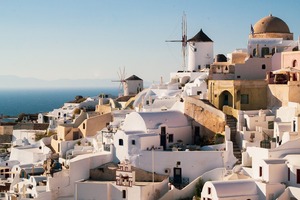Pilgrimage Tourism: Sacred Journeys to Spiritual Destinations
Publicado por brewno mass
Cuerpo
Pilgrimage destinations are visited for religious, spiritual, or personal enlightenment. Embarking on a pilgrimage tourism trip is a unique form of travel where people visit sacred destinations. This age-old tradition spans across cultures and faiths, offering travelers a deep connection with their beliefs.
Whether it is walking the Camino de Santiago, visiting Varanasi, or meditating in a secluded Buddhist monastery. These journeys hold profound meaning for many. Pilgrimage is not only about visiting holy sites; but also about inner transformation. It further offers a chance to do self-discovery, and experiencing faith in its purest form.
Above all, these sacred paths have shaped cultures, economies, and traditions worldwide. Historical accounts highlight that pilgrimage routes played a crucial role in the expansion of trade. They further spread of spiritual teachings, and the forging of inter-religious dialogues.
A journey to pilgrimage destinations can also be a deeply personal experience. Many set out on these sacred trails to seek answers to life's questions, overcome personal struggles, or fulfill vows made in times of crisis.
Even non-religious visitors often find inspiration and peace at these destinations. Above all, pilgrimage tourism isn't just for the devout. It is also for those who seek spiritual reflection, cultural enrichment, and historical insight.
Studies show that pilgrimage experiences can reduce stress and enhance emotional resilience. They meanwhile create a sense of interconnectedness with the divine and fellow travelers.
They meanwhile protect historical and spiritual integrity also. Local artisans, religious institutions, and hospitality businesses thrive due to pilgrimage tourism. That further makes it an essential economic driver in many regions.
Destinations for example Mount Kailash promote sustainable trekking practices to preserve their sanctity. Many pilgrimage sites are now incorporating green initiatives. That are banning single-use plastics, promoting carbon-neutral travel, and encouraging visitors to contribute to conservation efforts.
Additionally, many pilgrimage routes require logistical planning. For example obtaining permits, arranging transportation, and preparing spiritually through prayer, fasting, or meditation.
Many pilgrimage sites further offer virtual tours and online prayer services. That allow those who are unable to travel to still experience the spiritual essence of these sacred places.
Many governments and religious organizations invest in infrastructure improvements to accommodate the growing number of visitors. Further, they ensure safety and convenience.
Whether it is a solo spiritual retreat or a guided group journey, pilgrimage tourism offers a path toward personal growth. That further offers enlightenment, and a deeper connection with the divine and the world around us.
Whether it is walking the Camino de Santiago, visiting Varanasi, or meditating in a secluded Buddhist monastery. These journeys hold profound meaning for many. Pilgrimage is not only about visiting holy sites; but also about inner transformation. It further offers a chance to do self-discovery, and experiencing faith in its purest form.
The Historical Significance of Pilgrimage
From ancient times, pilgrimage has been a central aspect of various religions. In Christianity, the journey to Jerusalem’s Holy Sepulchre has attracted believers for centuries. Islam’s Hajj to Mecca and Hinduism’s Kumbh Mela are prime examples. These sacred journeys to spiritual destinations meanwhile shows how faith and travel intertwine.Above all, these sacred paths have shaped cultures, economies, and traditions worldwide. Historical accounts highlight that pilgrimage routes played a crucial role in the expansion of trade. They further spread of spiritual teachings, and the forging of inter-religious dialogues.
Why People Embark on Pilgrimages
For many, pilgrimage tourism is about spiritual renewal and finding deeper meaning in life. Some seek divine blessings, while others embark on these journeys to reflect, heal, or simply explore their faith. Beyond religion, it also offers a chance to connect with history, nature, and like-minded travelers.A journey to pilgrimage destinations can also be a deeply personal experience. Many set out on these sacred trails to seek answers to life's questions, overcome personal struggles, or fulfill vows made in times of crisis.
The Role of Faith in Pilgrimage Tourism
Faith plays a pivotal role in motivating travelers to undertake sacred journeys. Whether it is Christianity, Islam, Hinduism, Buddhism, or other traditions. Each of the pilgrimage destinations carries religious significance that draws millions annually.Even non-religious visitors often find inspiration and peace at these destinations. Above all, pilgrimage tourism isn't just for the devout. It is also for those who seek spiritual reflection, cultural enrichment, and historical insight.
Spiritual Benefits of Pilgrimage Travel
Beyond its religious significance, pilgrimage tourism provides mental clarity and emotional rejuvenation. Walk for days on end, meditate at holy sites, or participate in ancient rituals. That can lead to a profound sense of inner peace and fulfillment. Above all, many travelers return with a renewed outlook on life.Studies show that pilgrimage experiences can reduce stress and enhance emotional resilience. They meanwhile create a sense of interconnectedness with the divine and fellow travelers.
Cultural and Social Impact of Pilgrimage Tourism
Pilgrimage tourism fosters cross-cultural interactions, bringing people of different backgrounds together. It helps to preserve sacred traditions while boosting local economies. Many pilgrimage sites have developed sustainable tourism initiatives to manage large crowds.They meanwhile protect historical and spiritual integrity also. Local artisans, religious institutions, and hospitality businesses thrive due to pilgrimage tourism. That further makes it an essential economic driver in many regions.
Eco-Pilgrimage: A Sustainable Approach
With the rise of responsible travel, eco-pilgrimage is gaining popularity. Pilgrims are increasingly mindful of their environmental impact. They are opting for eco-friendly accommodations, reducing waste, and respecting natural surroundings.Destinations for example Mount Kailash promote sustainable trekking practices to preserve their sanctity. Many pilgrimage sites are now incorporating green initiatives. That are banning single-use plastics, promoting carbon-neutral travel, and encouraging visitors to contribute to conservation efforts.
How to Prepare for a Pilgrimage Journey
Preparation is key for an enriching pilgrimage experience. Travelers should research religious customs, pack appropriately. That firstly ensure they are physically ready for long walks or challenging terrains. Understanding local traditions enhances the experience and ensures respectful interactions with sacred sites.Additionally, many pilgrimage routes require logistical planning. For example obtaining permits, arranging transportation, and preparing spiritually through prayer, fasting, or meditation.
Modern Pilgrimage: Blending Tradition with Convenience
Above all, with advancements in travel, modern pilgrimage tourism has evolved. Today, pilgrims have access to guided tours, digital maps, and accommodations that cater to their needs. Yet, despite these conveniences, the core essence of these journeys remains deeply spiritual and transformative.Many pilgrimage sites further offer virtual tours and online prayer services. That allow those who are unable to travel to still experience the spiritual essence of these sacred places.
The Economic Contribution of Pilgrimage Tourism
Pilgrimage tourism significantly contributes to local and global economies. It supports religious institutions, hotels, restaurants, transport services, and artisans selling religious artifacts. Countries for example Saudi Arabia, India, and Spain see millions of pilgrims annually, boosting their tourism sector.Many governments and religious organizations invest in infrastructure improvements to accommodate the growing number of visitors. Further, they ensure safety and convenience.
Conclusion: A Journey of Faith and Discovery
Pilgrimage tourism continues to inspire millions worldwide. Whether for religious devotion, spiritual awakening, or cultural exploration. These sacred journeys leave an indelible mark on the hearts of travelers. As more people seek meaningful experiences, the timeless tradition of pilgrimage remains as relevant as ever.Whether it is a solo spiritual retreat or a guided group journey, pilgrimage tourism offers a path toward personal growth. That further offers enlightenment, and a deeper connection with the divine and the world around us.












Comentarios